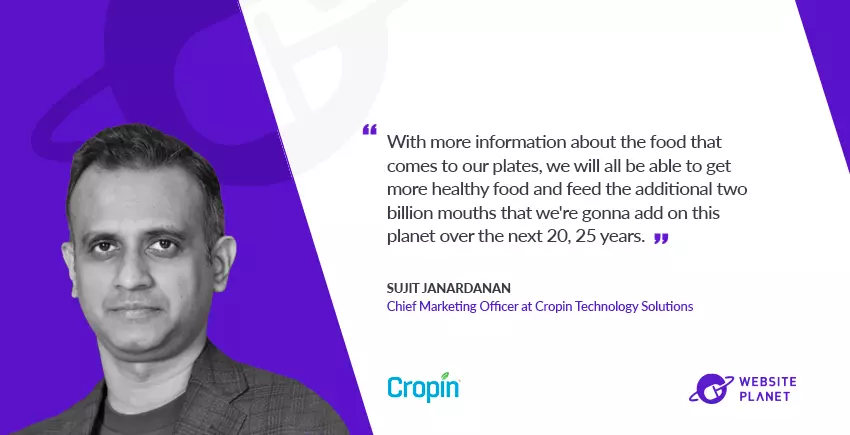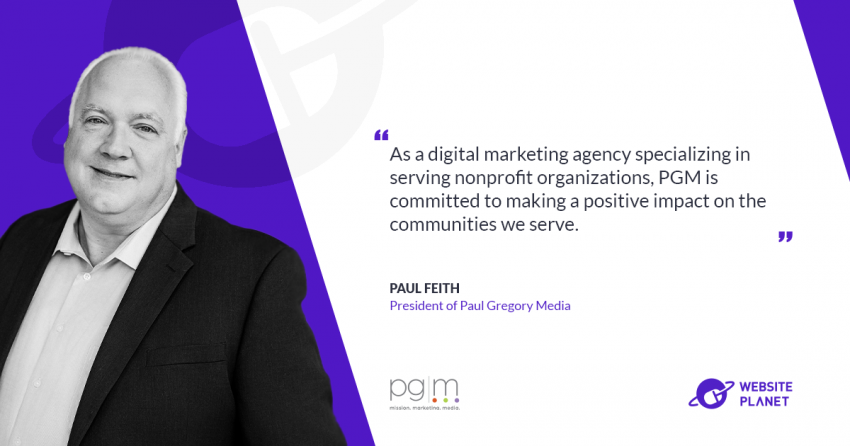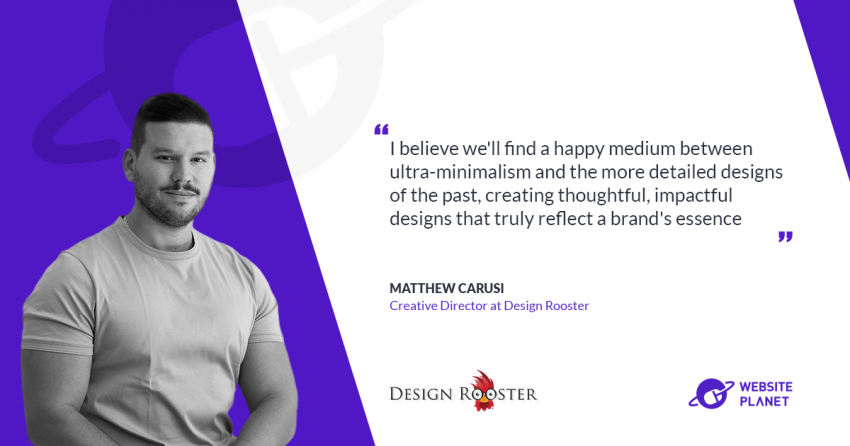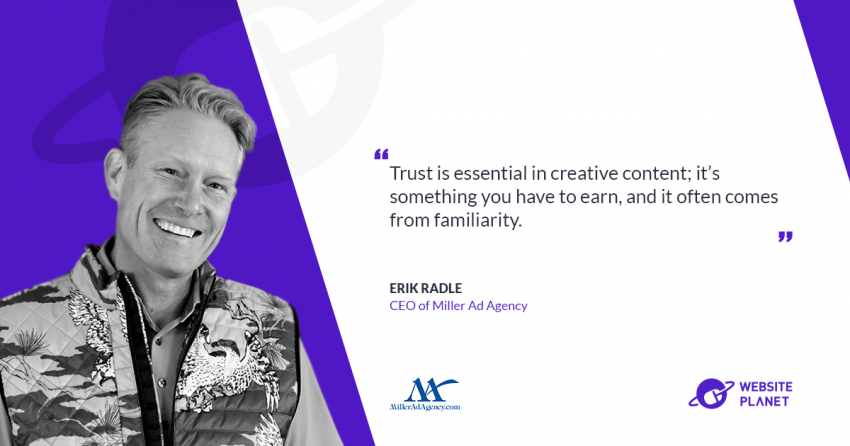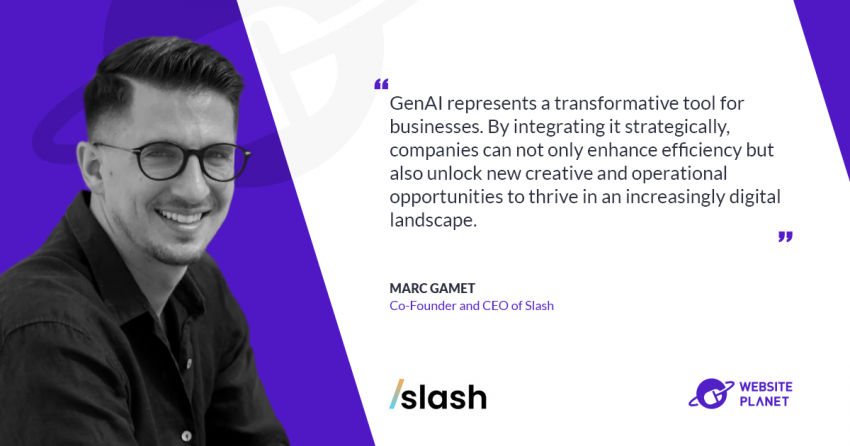Website Planet had the chance to sit down and chat with Sujit Janardanan, Chief Marketing Officer at Cropin Technology Solutions, a pioneer Agtech company providing predictive intelligence for over 0.2 billion acres of farmlands across the globe.
Sujit has been recognized as one of the 50 Most Talented CMOs of India by the CMO Council and World Brand Congress in 2013, and has led global and regional marketing for brands like Google, AWS, NTT (Netmagic), McAfee and 3i Infotech. He helped Cropin build its unique product and become the most admired brand in the Agritech niche.
He told us how Cropin was able to boost the ROI of over 7 million farmers,, and how they plan to keep improving peoples’ lives while increasing their own ARR.
What led you to join Cropin?
I’ve been with Cropin a little over two years now, and I’ve been in the technology space now, for 24 years, selling, and marketing, technology solutions of, which the last decade, and half, has been focused on selling and marketing public cloud services across infrastructure as a service platform as a service and software as a service. My last stint before joining Cropin was with Google where I helped build out the Google Cloud business in the South Asian market, pretty much from scratch.
The first reason, for actually joining Cropin, was the vision that it had in terms of creating impact in a sector like agriculture, which I really did not know a lot about. Another thing that really stood out for me as I was making my decision to join Cropin, was the scale of the impact that its solutions can deliver both in terms of social impact as well as economic impact.
The second key reason was, I love the passion with which Krishna was building out Cropin, because he started way back in 2010 when agriculture technology or agritech was not even a coined word. No one understood how digital could enable agriculture and what kind of solutions could be built, but he started nonetheless, and he remained true to his vision.
So, those are the two key reasons why I decided to join Cropin and it’s been an exhilarating journey (We still building!).
Agriculture is still a digital laggard as compared to several other industries, like manufacturing or BFSI, but it is a critical sector that needs to be enabled with digital technologies and that’s where we really focus. It’s still day one for us.
What’s the long term vision for Cropin?
Our vision is to make every single farm on this planet traceable. When I say traceable, I mean that I should be able to figure out what’s going on at farm level, without having to actually go there. Once we make farms traceable, then we can help them become more productive as well as sustainable, not just the farm assets, but also for the farmer’s livelihoods.
In order to improve farmers’ lives and make farming sustainable for the years to come, we need to maximize the value that we can get out of every acre of land that is being cultivated on this planet. So that everyone right from the farmer to the consumer (which is people like you and me who consume the produce that comes from the farm) can get more value.
So, for example, enabling a farmer to optimize the usage of soil and water resources, reducing the amount of chemicals that they use to grow.
Can I get more value there as a consumer, like you and me?
Can I help get more healthy food?
Can I know where my food was grown? Can I know who grew my food?
With more information about the food that comes to our plates, we will all be able to get more nutritious food and feed the additional two billion mouths that we’re gonna add on this planet over the next 20-25 years. So it’s about being able to produce more for all human mouths on this planet – That’s how we see the impact of our vision.
How are the solutions on your platforms helping with this?
Here I need to take you through Cropin’s journey. That will give you a sense of how we have built the solutions we are offering right now.
2010 – when Cropin started, the biggest challenge that existed in this sector was the fact that everything was driven using pen and paper. So, anyone who’s working with growers and farmers on the field, were using pen and paper or the knowledge and information that farmers have is in their heads.
If anyone wanted to do anything, there was no access to real-time data from the field, because Nothing was digitized – Everything was pen and paper and there was a lot of time-waste.
Agriculture is an industry that runs every second non-stop. The crop is always growing every second, every moment, every day, every week, just nature, it cannot stop. Therefore, you need real-time information about what’s going on in the field to avoid making reactive late decisions.
Take, for example, a sudden heatwave or a rainfall. If it’s not forecasted early, the necessary actions will not be taken on the farm’s ground, and you’re going to lose everything.
That’s where we started building what we call today “the digitization layer of
Cropin Cloud, the world’s first industry cloud for agriculture” – our Cropin Apps, which has three primary solutions:
Cropin Grow
Think of this as the ERP and CRM solution for everything that happens at a farm level in terms of operations, from what a farmer does on the field, what package of practices they follow to grow a crop to information’s about the farmer’s assetse.g farm equipment..
Do they have a water source available like an irrigation system? Any other KYC or social information that you would want to capture.
All of those pieces are captured with Cropin Grow.
Cropin Connect
This solutionenables agri businesses, governments, etc. to have a two-way engagement with farmers. If you can send information to farmers and farmers can communicate back with these ecosystem stakeholders.
Cropin Trace
A simple traceability solution, which enables traceability of food produced in a farm right up to the fork once it reaches the consumer.
So the combination of these three applications is what we created in the digitization layer, which is called Cropin Apps. So we are a B2B player – We don’t work with growers and farmers directly and there’s a reason for that, which I’ll cover shortly.
Our early adopters started asking us a question…
“Hey, you’re helping me collect this data… But I want to be able to do more with this data. How can you help?”
That’s where we started building out the data management layer, where we are able to help customers
build reporting dashboards so that they can analyze all the data and make better decisions.
We also started enabling them to integrate additional data sources beyond what our applications collect. So, for example, they can bring in satellite data, IoT devices, weather data from third parties etc. They can also bring data from their own other applications, which could be anything like SAP or other ERP or CRM tools etc, that they may have to be able to integrate everything and start correlating information on a single platform. That is what we call
Cropin Data Hub.
However, once we started building the data management layer, we also saw the opportunity to r bring predictive intelligence into play because, like I said, this is a sector where everything happens every moment.
If I can bring forecasting estimates or predictive capabilities into the solution, it will help mitigate a lot of the risks that the sector faces. And that’s whywe created Cropin AI Labs, a team of experts that includes data scientists for earth observation, scientists specialized in machine learning, cloud platforms experts and agronomy scientists.
All of them worked together to build machine learning models to start building predictive intelligence we use to solve farming problems.
Can I use satellite data and weatherr data sources to compute things? Can you identify the crop that’s been grown? Can I estimate the acreage for this crop in a particular region? Can I understand what the current crop growth stage is? Can I understand the crop’s health? What’s the water stress at a farm level? How can I give early warning signals for pest or disease infestation on a farm?
These kinds of solutions are what we started building. And that layer is now built as Cropin Intelligence, which today is part of the one single integrated platform called Cropin Cloud. That is what we are now taking to market because this sector has been plagued by what I call “the curse of too many point solutions” that do not solve things comprehensively.
We created Cropin Cloud so that customers can do more and bring in 3rd-party solutions to integrate. So we are the first cloud ecosystem platform that this industry has ever had.
What is still missing in the AgriTech space?
When you look at governments, development agencies, agri businesses themselves, they are all pouring millions of dollars to solve the digitization problem, but I would say we are hardly moving the needle.
In fact, despite all that investment,
there is a dire need for all of us to really think of this as an ecosystem and not as multiple solutions doing one thing each, because at the end of the value chain there is always the farmer. They’re all talking to the same farmer that crop protection companies like Bayer, or a seed company like Syngenta or a development agency like World Bank are talking to
They expect a farmer to start downloading and accessing 10 different mobile applications and get information from 10 different sources, but farmers have better things to do. They want to grow crops the right way so they get paid right for it, live better and rest assured that the next generation finds it sustainable to continue the profession. Otherwise youngsters will quit farming and migrate to cities and
we will not have anyone growing food for us.
How do you plan to cope and evolve according to that?
We are going to commit to our vision of being an ecosystem platform.
The one piece that we are doubling down on is building integrations with more and more third-party solutions, not just ours, because we know that we can’t solve everything that our customers will need to solve all the challenges in the agriculture sector.
But that is a tough one, because this sector is still in very early stages. So even if I want to go and integrate with another solution provider, it could be a satellite imagery provider, or It could be a weather data provider or a third-party digitization application.
The fact is that all of us are still in very early stages of growth, which means that we don’t have the maturity to be able to even have a collaborative conversation on how to build these integrations and think in terms of an ecosystem. I think that’s where we need a lot more investments, that’s how you want to solve the agriculture and food problem – More comprehensively.
There are trillions of dollars being spent, but I believe that if we all double down on investing in the digitization industry, a lot of the challenges that the agriculture sector is facing can be solved. That’s why we are doubling down on the ecosystem vision and building a lot more of those integrations and partnerships proactively.
The second area that we are really focusing on is waiting and
building with our clientele. That is critical because each of these customers have been there for decades, if not for centuries, so they have a lot of historic legacy both in terms of data and know-how.
They are worried about what the future is going to hold, because the future is unpredictable (the way climate changes, the way our resources, like soil and water are getting depleted, the way agriculture impacts climate etc.)
Just look at Europe facing unprecedented heat waves, or India getting flooded, cold waves in places like Brazil. These kinds of changes are throwing challenges that we were not prepared for and the farmers understand it. They need to solve these issues asap.
These businesses operate differently, they have different business models, etc., so we have to work with them to innovate and build together bespoke solutions to solve each challenge, but at the same time take some of those best practices that we build out with our customers and take them to the larger ecosystem and industry players too.
Digitizing farming for women
We’ve been able to enable women farmers as part of a project in India, where typically the men are the ones who work on the crops. So how do you help more and more women farmers start getting into farming while a lot of Indian men actually decide to go and work in urban cities? The land is left behind to the women and the children, who must try to do something with it.
Our goal in collaboration with the World Bank and a couple of state governments were enabling women farmers with information, like whether data, tackle pest and disease infestation, all of that package of practices that they can apply from a climate smart practice perspective so that they can confidently grow crops and start earning sustainable livelihoods out of their farmlands even if they were doing this for the first time.
Case studies
One client had a goal to enable farmers to grow quality potatoes, but at the same time handle the risks that come as a result of climate change. That way they could help them produce more and more produce in the process. Using predictive intelligence we gave them insights on what kind of yield they can expect from the potato farmers that they’re working with.
If they can estimate the yield that can come out of the potato farms that they contracted with, they will be able to make better supply and demand decisions – much better decisions – and that directly impacts both the top and bottom line besides, obviously, ensuring that the farmer gets the best price.
Another example is when we work with seed companies, helping them manage their trial and R&D processes, so they can cut down the overall R&D time which typically takes around eight years, which is a long time before they can get a seed commercially into the market.
We are helping them cut down the time there and identify those commercially viable seeds that grow and multiply faster, so they can sell more of them.
Also tied back to the supply chain, we help our users understand the supply and demand, so they don’t over produce (or under produce). So that’s another example of our solution use case.
We are also working directly with governments. For example, we help the Nigeria government to predict the yield of one of their primary crops, which is wheat, one they both produce and import, so they can make import policies and specific decisions.
Another example is where we have been working with the Indian government on the world’s largest crop insurance program: the
Pradhan Mantri Fasal Bima Yojana (
PMFBY) in India. We have been using our solutions along with the hybrid framework, which includes crop cutting experiments on the field level to set the right premiums and help with any claim settlement with a lot more confidence and accuracy.
What feedback are you receiving now from your clients?
I think there are two parts that the customers really resonate when they choose to partner with Cropin, and why they continue to partner with Cropin.
1. We are constantly pushing the boundaries of what is possible. We are innovating along with them and its all about what they need. So they clearly see us as a partner for the long run because they know there is someone who’s going to run with them as fast as them or faster than them.
2. The second component is really the scale and experience that we bring on the table. I would say there are next to none and tactic solutions that are deployed across 92 countries. That showcases the fact that we are a solution provider that is really able to build something that can scale and be customized to what one’s requirements are.
Our guys have been there and done that, so they know how to make it happen.
Those are the two pieces that really resonate with the customers and the reason why we always get recommended, and we continue to work with some of these customers that we work with.
How is your support structured?
We are a B2B provider so ours is an enterprise grade solution. Think Salesforce or SAP.
The challenge really is the fact that those are complex solutions, especially when you’re trying to deploy them for something as complex as agriculture. It is not at all straightforward.
So
we have a one-on-one customer success framework, where we have customer success team members working with our customers to deploy Cropin solutions or the Cropin Cloud platform successfully. And we also work with them as they keep trying to do more and more with the platform.
But even before that we’ve got a solution specialist team who actually works with the customer when they’re starting with us to fully understand what is their business case, and what are the business processes, the customer success team works with the customer’s Program Management team to define and deploy the solutions that benefit them the most. That’s the role that we are doubling down on.
It’s about change management more than mere technology deployment, and that’s another component that we are building more and more capabilities around, so we can help customers drive change within their users and the organization that they are probably deploying our technologies. That’s how we work with our customers.
The last point I would like to make is, we understand the business processes, we understand what is the current technology landscape, and we understand what’s the kind of change management required. We bring in best practices from customers who have solved something similar, so that we can bring the best of Cropin to each customer. All of that is done through this combination of the solution specialist team and customer success.
